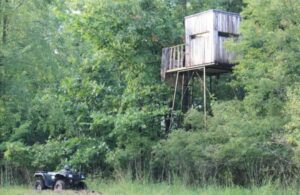
Hunting is as much a science as it is an art. Among the many strategies employed by hunters, camouflage stands out as a crucial tool for staying concealed from the keen eyes of game animals. But how does it work, and what’s the science behind camouflage patterns? In this article, we’ll delve into the fascinating world of camouflage and explore how hunters can harness its power to stay hidden in their deer blinds.
The Basics of Camouflage:
Camouflage is the art of making oneself or an object blend into its surroundings, making it less visible to potential threats or prey. It relies on several key principles:
- Disruptive Patterns: Disruptive patterns break up the outline of an object by using contrasting colors, shapes, and lines. These patterns create confusion for the observer’s brain, making it harder to recognize the object.
- Mimicry: Camouflage can mimic elements of the environment, such as leaves, branches, or rocks. This makes the camouflaged object appear like a natural part of the landscape.
- Background Matching: Effective camouflage closely matches the color and texture of the background against which it will be used. This reduces the chances of being detected by blending in seamlessly.
How Camouflage Works in the Wild:
In nature, many animals have evolved their own forms of camouflage to avoid predators or enhance their hunting success. For example:
- The leaf-tailed gecko of Madagascar looks remarkably like a dead leaf, with its body resembling the texture and coloration of a fallen leaf.
- The snowshoe hare changes its fur color from brown in summer to white in winter to match its surroundings, providing excellent winter camouflage.
- The chameleon can change the color and pattern of its skin to match its environment, helping it remain hidden from both predators and prey.
Camouflage in Hunting Deer Blinds:
When hunting from a deer blind, the principles of camouflage can be applied to both the blind itself and the clothing of the hunter. Here’s how to use camouflage effectively:
- Blind Camouflage: Choose a ground blind with a camouflage pattern that matches the environment where you’ll be hunting. This helps the blind blend into the surroundings, making it less noticeable to approaching game.
- Clothing: Wear camouflage clothing that matches the terrain. This includes camo patterns for pants, shirts, hats, and even gloves. Ensure that your clothing pattern matches the environment where you’ll be hunting.
- Face and Hands: Don’t forget to camouflage your face and hands, as these are often the most visible parts of a hunter. Camo face paint or a camo face mask can help you stay hidden.
- Limit Movement: Even with the best camouflage, excessive movement can give away your position. Move slowly and deliberately, and avoid sudden gestures that might catch the eye of game animals.
- Terrain Considerations: Adjust your camouflage to the specific terrain. A woodland camo pattern may not work as well in an open field, so adapt your clothing and gear accordingly.
- Stay Downwind: No matter how effective your camouflage, scent can give you away. Always position yourself downwind from where you expect deer to approach to minimize scent detection.
In conclusion, the science of camouflage is a powerful tool for hunters seeking success from their deer blinds. Understanding the principles of disruptive patterns, mimicry, and background matching can help you select the right camouflage gear and set up your blind effectively. By blending into your surroundings, you increase your chances of remaining undetected and having a successful hunt. Camouflage is not just a pattern; it’s a strategy that allows hunters to become invisible observers in the natural world.


Leave a Reply
You must be logged in to post a comment.